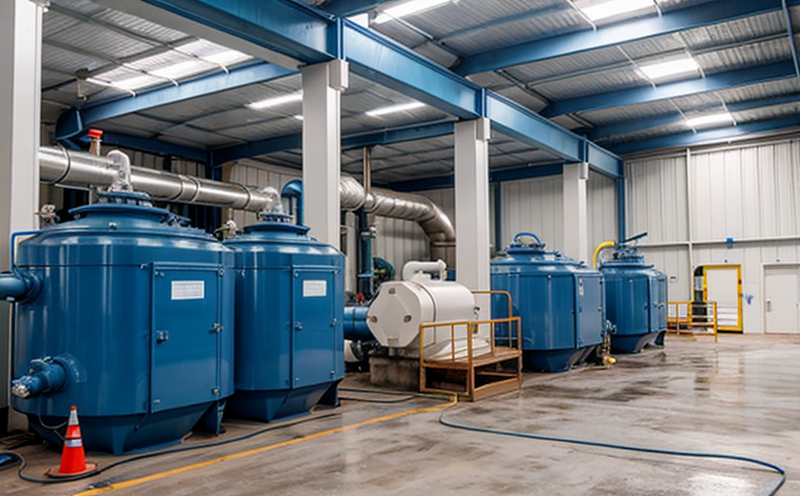ISO 11732 Ammonium Testing in Wastewater
The ISO 11732 standard is pivotal in the marine and ship equipment testing sector, particularly for ballast water and wastewater treatment systems. This method provides a standardized approach to quantifying ammonium levels in wastewater, which is critical for ensuring compliance with international regulations aimed at reducing environmental impacts from ships' discharges.
Ammonium plays a key role in the nitrogen cycle, and its presence can contribute significantly to aquatic eutrophication if not properly managed. The ISO 11732 test measures ammonium concentrations through colorimetric analysis using a spectrophotometer. This method is widely used for quality assurance and control in wastewater treatment processes.
The testing process involves several steps: sampling, digestion of the sample to ensure complete decomposition of organic matter, and the subsequent measurement of ammonia nitrogen concentration by titration or colorimetric assay. The results are reported as milligrams per liter (mg/L) of ammonium-nitrogen in the wastewater sample.
The importance of this testing cannot be overstated for compliance with international standards such as ISM Code, MEPC.159(57), and MARPOL Annex I & II, which mandate strict control over ballast water and shipboard waste discharge to prevent harmful aquatic organisms and pathogens from entering or leaving regulated waters.
Our laboratory adheres meticulously to the ISO 11732 procedure, ensuring that our testing is accurate and reliable. Our state-of-the-art facilities are equipped with advanced instrumentation capable of delivering precise results within tight tolerances. We provide comprehensive reports detailing test procedures, raw data, and final concentrations, which are essential for decision-making processes in quality management and regulatory compliance.
For R&D engineers working on improving wastewater treatment systems, this testing method offers critical insights into the efficacy of new technologies and methodologies. Compliance officers can use these results to ensure their vessels meet stringent environmental regulations, thereby avoiding potential legal penalties and reputational damage.
Why It Matters
The accurate measurement of ammonium in wastewater is crucial for several reasons:
- To ensure compliance with international standards such as ISM Code and MARPOL Annexes I & II.
- To prevent the introduction of harmful organisms into new waters, thus protecting local ecosystems.
- To minimize the risk of pathogen transfer between ships and coastal areas.
- To support the development and optimization of wastewater treatment systems for marine applications.
By adhering to ISO 11732 standards, we contribute significantly to environmental protection and sustainable maritime practices. This testing is not only a regulatory requirement but also an essential tool in maintaining the integrity of our oceans and waterways.
Scope and Methodology
The scope of ISO 11732 covers the determination of ammonium-nitrogen concentrations in various types of wastewater, including ballast water from ships. The method is applicable to both laboratory and on-board testing environments.
| Step | Procedure |
|---|---|
| Sample Collection | Collect representative samples using a calibrated sampler, ensuring proper preservation of the sample for digestion. |
| Sample Digestion | Digest the collected sample at 165°C for two hours to ensure complete decomposition of organic matter. Cool and transfer the digested sample to a clean, volumetric flask. |
| Titration or Colorimetry | Perform titration using standard sodium thiosulfate solution or use colorimetric analysis with a spectrophotometer calibrated for ammonium-nitrogen. |
| Result Calculation | The final result is reported as the concentration of ammonium-nitrogen in mg/L, calculated based on the volume of titrant used and the sample dilution factor. |
The precision and accuracy of this testing method are ensured by rigorous quality control measures, including regular calibration checks and proficiency testing with reference materials.
Use Cases and Application Examples
- Ballast Water Management: Testing ammonium levels in ballast water helps ships comply with regulations aimed at preventing the introduction of invasive species into new waters.
- Wastewater Treatment Optimization: By monitoring ammonium concentrations, R&D teams can refine treatment processes to achieve optimal removal rates and minimize environmental impact.
- On-Board Compliance Monitoring: Regular testing onboard ships ensures ongoing compliance with regulatory limits for ammonia-nitrogen discharge.
- Environmental Impact Assessment: Long-term monitoring of ammonium levels in ship effluents provides valuable data for assessing the ecological health of receiving waters.
In addition to these use cases, ISO 11732 testing is also essential for quality assurance programs within shipyards and maritime facilities. By ensuring consistent results across different samples and environments, this method plays a vital role in maintaining high standards of environmental stewardship.





